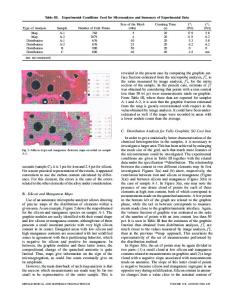The role of interphase boundary adsorption in the formation of spheroidal graphite in cast iron
- PDF / 6,079,098 Bytes
- 13 Pages / 612 x 792 pts (letter) Page_size
- 22 Downloads / 299 Views
THE
modification of flake graphite in gray iron t o the spherulitic or nodular form in ductile iron is of considerable technological importance. Although studied extensively over the years, ~-a the mechanism by which magnesium or c e r i u m additions change the graphite morphology is almost as u n c e r tain today as it was in 1948 when Morrough f i r s t reported the process.4 When F e - C - S i alloys of eutectic or near eutectic composition are cast*, the usual r e s u l t is gray iron *Forcast irons, the effective carbon composition, thecarbon equivalent, CE =wtpct C+~/awt pct Si, is generally usedto specify a composition relative tothe Fe-C binary phase diagram. with a microstructure s i m i l a r t o that in Fig. l ( a ) . The graphite phase grows in the form of flakes, with a structure consisting of layers of graphite b a s a l planes stacked together to form sheets, Fig. l(b). C r a c k nucleation and propagation through a microstructure such as that in Fig. l(a) is relatively easy due to the almost continuous brittle graphite phase. However, when s m a l l amounts (0.1 wt pct) of magn e s i u m a n d / o r c e r i u m are added t o the melt just p r i o r t o casting, the resulting cast iron has a much different microstructure, Fig. 2(a). In this ductile iron, the graphite phase grows as polycrystalline spherulites or nodules. The structure of a graphite nodule is shown schematically in Fig. 2(b), and it is obvious that a drastic change has occurred in the growth morphology of the graphite phase after modification. Since these polycrystalline particles are more difficult to fracture than flakes, and a c r a c k cannot follow a semicontinuous path of graphite, the fracture toughness of ductile iron is considerably g r e a t e r than that of gray iron. 1~ A review of the previous work indicates that most
W.C. JOHNSON and H. B. SMARTT are Senior Research Scientists, Research Staff, Ford Motor Company, Dearborn,MI48121. Manuscr pt submitted August 20, 1976. METALLURGICAL TRANSACTIONS A
(a)
Basal Plane/ (b) Fig. 1--Structure of gray iron; (a) mierostrueture iron, and (b) s c h e m a t i c of flake structure.
of gray
VOLUME 8A, APRIL 1977-553
i:
• i
ff~
I. E X P E R I M E N T A L
P
A) Materials T h e g r a y i r o n c h o s e n f o r t h e study was o f t y p i c a l commercial quality. P r o d u c e d from induction melted b a s e i r o n , i t w a s s t r e a m i n n o c u l a t e d w i t h F e S i , 14 a n d c a s t into a g r e e n s a n d m o l d . T h e r e s u l t i n g a s - c a s t microstructure, Fig. l(a), consisted o f g r a p h i t e f l a k e s s u r r o u n d e d by f e r r i t e a n d p e a r l i t e . T h e two ductile i r o n s e x a m i n e d in t h e s t u d y were also p r o d u c e d f r o m induction m e l t e d base i r o n . All o y 1 8 - A was s t r e a m m o d i f i e d w i t h a 5 p c t M g F e S i a l l o y , 14 a n d c a s t into a g r e e n s a n d m o l d w i t h o u t a p o s t i n n o c u l a n t . A l l o y 3 w a s m o d i f i e d w i t h 5 pct M g F e S i by p l
Data Loading...











